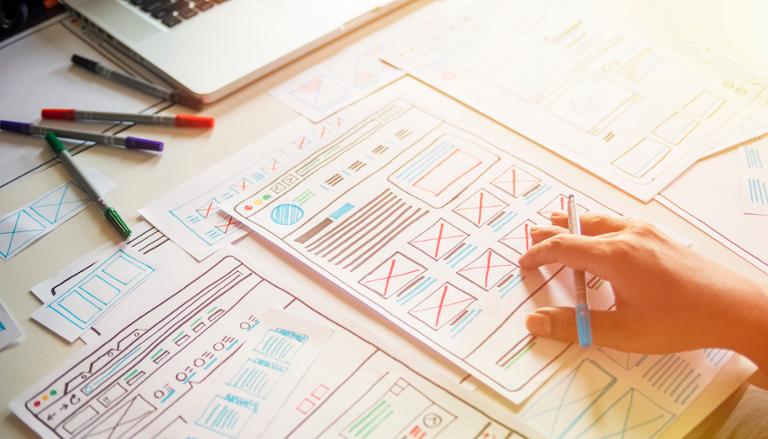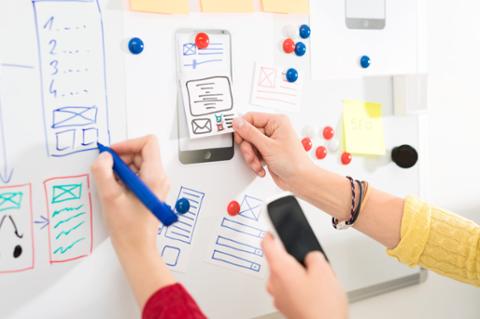User interaction (UI) and user experience (UX) designers rely on artistic instincts and technical skill. If they do their jobs right, most users won’t even notice how seamlessly they move through an app or website.
Although some folks use “UI” and “UX” interchangeably, it’s helpful to point out here that they’re actually very different. UI is what a user actually sees onscreen, including icons and any moving elements, while UX is how users interact with those UI elements. Fortunately, many of the same design skills and tools apply to both categories.
More companies are recognizing the need for UI and UX designers, which is why job growth for these professionals is expected to rise 14.9 percent over the next 10 years, according to Burning Glass, which collects and analyzes millions of job postings from across the country. These companies need designers who can build the next generation of websites, mobile apps, IoT interfaces, and many other things.
That multitude of devices and goals means that UI and UX designers must be flexible above all else. “For UX designers, the tools will constantly change, so designers need to be able to pick up tools quickly and have discretion over which tool is the ‘right tool for the job’,” explained Allison Mazzetti, product manager at Brookyln-based desktop 3D printing specialist MakerBot.
In the past, it was standard to export a design file and send it to the developers. “There might be a meeting or two to review, but that would be about it. The results varied from this approach—some may have experienced painstaking reviews between design and development,” Mazzetti said. “Other products suffered because the design was never implemented properly.”
But as products become more complex, successful UI/UX designers are increasingly expected to work at a more collaborative level than in the past. The “hands off” mentality when it comes to the intersection of design and engineering simply doesn’t work anymore.
Mazzetti thinks collaborative software such as Figma has helped in terms of allowing cross-functional teams to work on the same set of evolving assets, rather than what has been done in the past (i.e., handing over files with notes for engineers to translate).
“We have tools to help designers communicate their designs to developers and tools that easily translate designs to code. While the tools certainly help to bridge the gap, they cannot do it on their own,” she noted. “We need designers and developers who can collaborate to build on the efficiencies that the tools provide. Those who are able to bridge this gap between design and engineering will be invaluable to organizations.”
While technical chops with the latest tools is important, design thinking and problem solving will be what differentiates great designers from the good ones. According to Burning Glass, these are some of the top UI/UX skills currently popping up in job postings across the country:
“At many organizations, there will not be infinite resources to come up with the most elegant solution,” Mazzetti pointed out. “Instead, it’ll be a series of tradeoffs and coming up with the best solution to the most important problem.”
The industry needs designers who can analyze these tradeoffs and come up with elegant solutions to these difficult problems. While UI and UX designers don’t need to know as much about core technologies as the engineers who build them, they’ll still need some degree of familiarity with everything from firmware to cloud apps, depending on the project.
UI, UX, A.I. and ML
Kahlil Brewington, principal UX designer at digital business consultancy Nerdery, said UI and UX is evolving to a more user-centered and personalized focus, and predicted artificial intelligence (A.I.) and machine learning technologies would start to play a bigger role in how things are designed.
However, most companies won’t be readily equipped to dive into A.I. and ML applications, so it’s important for UX and UI designers to take the initiative and make themselves familiar with the technologies. “The good thing is with AI and ML, there’s a lot of free stuff out there to learn right now, because it’s still in the development stage, it’s a lot of algorithmic stuff,” Brewington said. “Get into it now, take bootcamps, look for free sessions, books you can read up on, make your own little chatbots.”
As the personalization of UI/UX develops, Brewington said it’s more essential than ever that designers go out into the real world and experience the way people interact and react to design languages and design systems: “The one skill needed is being able to listen to people in a way that’s empathetic, and being able to ask uncomfortable questions to get at the root of the problem, and get those pain points out of the way before the build session.”
Like Mazzetti, Brewington also pointed to the increasing need for organizational and communication and collaboration skills, which he said allow UI/UX designers to effectively incorporate feedback from stakeholders. If other teams can see prototypes and chime in, it only makes the final product stronger.
Brewington highlighted Figma as well as InVision (a digital product design, workflow and collaboration platform) as two key tools. Jamboard, an interactive whiteboard system developed by Google, and Miro, a similar platform, could also prove key toolsets for budding UI/UX designers.
“For any user experience designer, you have to always stay learning, because the only way you can stay relevant in this industry is to keep learning new things,” Brewington said. “If you’re not hungry for that knowledge, you’re going to be left behind.”


